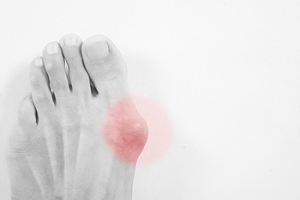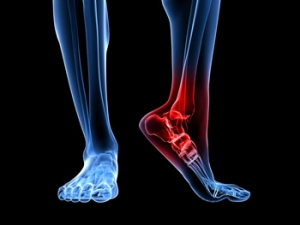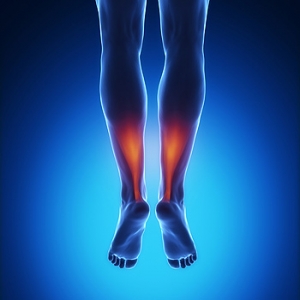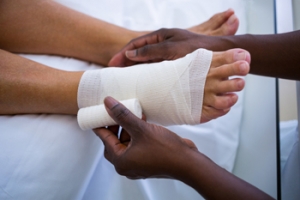Featured Articles
Super User
Wearing High Heels While Working
 Many patients experience foot pain at the end of their working day. This may be a result of wearing shoes that do not fit correctly, or it may come from standing for extended periods of time throughout the day. Some work environments require high heels to be worn. If this is true for you, it may be beneficial to wear the lowest heel that is acceptable in the work environment, in addition to frequently stretching the calf muscles during the day. Additionally, it may be favorable to wear shoes that are made of breathable materials, and to alternate them with another pair, as this may help to avoid discomfort. If you would like additional information about how to protect your feet while working, please schedule an appointment with a podiatrist.
Many patients experience foot pain at the end of their working day. This may be a result of wearing shoes that do not fit correctly, or it may come from standing for extended periods of time throughout the day. Some work environments require high heels to be worn. If this is true for you, it may be beneficial to wear the lowest heel that is acceptable in the work environment, in addition to frequently stretching the calf muscles during the day. Additionally, it may be favorable to wear shoes that are made of breathable materials, and to alternate them with another pair, as this may help to avoid discomfort. If you would like additional information about how to protect your feet while working, please schedule an appointment with a podiatrist.
While working on the feet, it is important to take the proper care of them. For more information about working on your feet, contact Dr. Dean D. Hinners from Illinois. Our doctor will treat your foot and ankle needs.
Working on Your Feet
Standing on your feet for long periods of time can cause stress and pain in your feet. Your whole body may experience change in terms of posture, back pain, bunions, callouses and or plantar warts. There are ways to avoid these conditions with proper foot care, smart choices and correct posture.
Positive Changes
Negative heeled shoe – Choosing this shoe type places the heel slightly lower than the ball of the foot. These are great for overall foot health. Find shoes that fit you correctly.
Go barefoot – Our feet were not designed to be enclosed for all hours of the day. Try to periodically expose your feet to air.
Eliminate Pain
Foot Exercises – Performing simple exercises, incorporating yoga and doing stretches are beneficial. This will allow increased blood flow to the area and muscles of the foot.
Achilles tendon – Stretching the foot out flat on the floor will relax the calf muscles and tendon. These exercises can be performed almost anywhere. Make sure you add these exercises to your daily regimen.
With a little bit of this information and knowing more about foot health, you will notice changes. Foot stretches and proper footwear will help with pain and prevent further issues.
If you have any questions please feel free to contact one of our offices located in Metropolis and Eldorado, IL . We offer the newest diagnostic and treatment technologies for all your foot and ankle needs.
Read more about How to Handle a Long Work Day on Your FeetHow to Handle a Long Work Day on Your Feet
In 2014, the American Podiatric Medical Association surveyed 1,000 American adults and found that half of all respondents lived with foot pain. Fortunately, there are ways to avoid foot problems such as following a daily footcare routine and wearing proper footwear at work.
If you have a job that requires you to be on your feet, it is best that you do not wear flat sole shoes. Your heel should be slightly elevated (less than 2 inches, but at least ¼-inch) if you are going to be standing for a prolonged period. You should also make sure that the shoes you wear are not too small. Tight shoes may cut off circulation to your feet, which will result in pain and blisters. It is always best to purchase fitted shoes later in the day, because the feet tend to swell as the day progresses. It may also be helpful to buy shoes a half size larger if you plan on wearing custom orthotics or arch supports.
Your muscles may become stiff when you are constantly standing up. It is important to take breaks every hour to stretch and relax. One tip is to perform calf raises, because this exercise will help improve your circulation. To perform this stretch, you first need to stand on the edge of a step with your abdominal muscles pulled inward. You then need to grip the step with the balls of your feet with your heels hanging over the edge. Next, try to raise your heels above the step by a few inches while standing on your tiptoes; hold this pose for a second. You should then lower your heels back even to the platform. These calf raises should be done ten times for full effectiveness.
You should also take care of your feet while you are at home. One of the best ways to prepare your feet for a long day of work is to soak them in ice water. Doing so for 20 minutes will help fight the swelling and inflammation that results from being on your feet at work.
Nevertheless, if you are experiencing pain in your feet, you should seek help from your podiatrist. Your doctor will help treat any ailments you may have in addition to helping you prevent any other ailments from developing in the future.
Possible Causes of Bunions
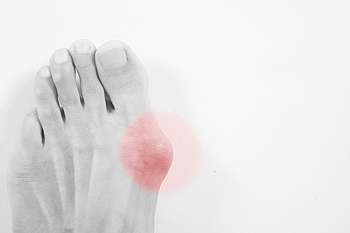 Patients who have developed bunions are often aware of the pain and discomfort they may cause. A bunion appears as a bony protrusion on the side of the big toe, and it may be difficult to wear shoes. Some of the symptoms that are associated with bunions can consist of redness and swelling on the bottom of the big toe, and the second toe may overlap the big toe. Genetic factors may play a significant role in developing bunions, in addition to wearing shoes that do not have adequate room for the toes to move freely in. Some patients may have existing medical conditions that can increase the risk of obtaining a bunion, such as flat feet, or neuromuscular conditions. It may be beneficial to wear custom made orthotics which may help to relieve some of the pressure that bunions can cause. If you have developed a bunion, please consult with a podiatrist who can help you to manage this ailment.
Patients who have developed bunions are often aware of the pain and discomfort they may cause. A bunion appears as a bony protrusion on the side of the big toe, and it may be difficult to wear shoes. Some of the symptoms that are associated with bunions can consist of redness and swelling on the bottom of the big toe, and the second toe may overlap the big toe. Genetic factors may play a significant role in developing bunions, in addition to wearing shoes that do not have adequate room for the toes to move freely in. Some patients may have existing medical conditions that can increase the risk of obtaining a bunion, such as flat feet, or neuromuscular conditions. It may be beneficial to wear custom made orthotics which may help to relieve some of the pressure that bunions can cause. If you have developed a bunion, please consult with a podiatrist who can help you to manage this ailment.
If you are suffering from bunions, contact Dr. Dean D. Hinners of Illinois. Our doctor can provide the care you need to keep you pain-free and on your feet.
What Is a Bunion?
A bunion is formed of swollen tissue or an enlargement of boney growth, usually located at the base joint of the toe that connects to the foot. The swelling occurs due to the bones in the big toe shifting inward, which impacts the other toes of the foot. This causes the area around the base of the big toe to become inflamed and painful.
Why Do Bunions Form?
Genetics – Susceptibility to bunions are often hereditary
Stress on the feet – Poorly fitted and uncomfortable footwear that places stress on feet, such as heels, can worsen existing bunions
How Are Bunions Diagnosed?
Doctors often perform two tests – blood tests and x-rays – when trying to diagnose bunions, especially in the early stages of development. Blood tests help determine if the foot pain is being caused by something else, such as arthritis, while x-rays provide a clear picture of your bone structure to your doctor.
How Are Bunions Treated?
- Refrain from wearing heels or similar shoes that cause discomfort
- Select wider shoes that can provide more comfort and reduce pain
- Anti-inflammatory and pain management drugs
- Orthotics or foot inserts
- Surgery
If you have any questions, please feel free to contact one of our offices located in Metropolis and Eldorado, IL . We offer the newest diagnostic and treatment technologies for all your foot care needs.
Read more about What Are Bunions?What Are Bunions?
Bunions are large bony bumps at the base of the big toe. Medically known as hallux valgus, a bunion is a misalignment of the metatarsophalangeal joint, or big toe joint. The misalignment will generally worsen with time if left untreated.
The exact cause of bunions is unknown, with genetics seen as a potential cause. High heels and poorly-fitted footwear, rheumatoid arthritis, and heredity all seem to be potential factors behind the exacerbation of bunions. Women have been found to be more likely to develop bunions in comparison to men.
Bunions do not always produce symptoms. The best way to tell is if the big toe is pushing up against the next toe and there is a large protrusion at the base of the big toe. You may or may not feel pain. Redness, swelling, and restricted movement of the big toe may be present as well.
Podiatrists use a variety of methods to diagnose bunions. If there are symptoms present, podiatrists will first consider that it is a bunion. If not, a physical examination will be conducted to check function of the big toe. Finally, an X-ray may be taken to view the extent of the bunion and confirm it is a bunion.
Typically, nonsurgical methods are used to treat bunions, unless the bunion has become too misaligned. Orthotics, icing and resting the foot, roomier and better fitted shoes, taping the foot, and pain medication are usually utilized first. If the bunion doesn’t go away or causes extreme pain, surgery may be required. Surgeons will either remove part of the swollen tissue or bone to straighten the toe out.
If you have a bunion, it is recommended to see a podiatrist. The longer it is left untreated, the worse it may get. Podiatrists can properly diagnose and treat a bunion before it gets worse.
Arthritis Can Cause Pain in the Feet and Ankles
Where Is the Plantar Fascia?
 The portion of tissue that is found on the bottom of the foot is called the plantar fascia. It connects the heel to the toes, and helps to provide flexibility to the foot while walking and running. When this band of tissue becomes inflamed as a result of an injury or from overuse, the condition plantar fasciitis may develop. The symptoms that are generally associated with this condition can include severe pain and discomfort in the heel and surrounding area, and this pain may be worse in the morning after arising. Some patients find mild relief when the affected foot is rolled on a cold bottle, as this may be helpful in relaxing the affected muscles. If you suffer from plantar fasciitis, it is strongly suggested that you are under the care of a podiatrist who can properly treat this condition.
The portion of tissue that is found on the bottom of the foot is called the plantar fascia. It connects the heel to the toes, and helps to provide flexibility to the foot while walking and running. When this band of tissue becomes inflamed as a result of an injury or from overuse, the condition plantar fasciitis may develop. The symptoms that are generally associated with this condition can include severe pain and discomfort in the heel and surrounding area, and this pain may be worse in the morning after arising. Some patients find mild relief when the affected foot is rolled on a cold bottle, as this may be helpful in relaxing the affected muscles. If you suffer from plantar fasciitis, it is strongly suggested that you are under the care of a podiatrist who can properly treat this condition.
Plantar fasciitis can be very painful and inconvenient. If you are experiencing heel pain or symptoms of plantar fasciitis, contact Dr. Dean D. Hinners from Illinois. Our doctor can provide the care you need to keep you pain-free and on your feet.
What Is Plantar Fasciitis?
Plantar fasciitis is the inflammation of the thick band of tissue that runs along the bottom of your foot, known as the plantar fascia, and causes mild to severe heel pain.
What Causes Plantar Fasciitis?
- Excessive running
- Non-supportive shoes
- Overpronation
- Repeated stretching and tearing of the plantar fascia
How Can It Be Treated?
- Conservative measures – anti-inflammatories, ice packs, stretching exercises, physical therapy, orthotic devices
- Shockwave therapy – sound waves are sent to the affected area to facilitate healing and are usually used for chronic cases of plantar fasciitis
- Surgery – usually only used as a last resort when all else fails. The plantar fascia can be surgically detached from the heel
While very treatable, plantar fasciitis is definitely not something that should be ignored. Especially in severe cases, speaking to your doctor right away is highly recommended to avoid complications and severe heel pain. Your podiatrist can work with you to provide the appropriate treatment options tailored to your condition.
If you have any questions please feel free to contact one of our offices located in Metropolis and Eldorado, IL . We offer the newest diagnostic and treatment technologies for all your foot and ankle needs.
Read more about Plantar FasciitisPlantar Fasciitis
The plantar fascia is a connective tissue in the heel that stretches across the bottom length of your foot. Plantar fasciitis occurs when the connective tissue becomes inflamed, causing heel pain and discomfort during physical activity. Although the condition is completely treatable, traditional methods can take up to a year to start becoming effective.
Plantar fasciitis is caused by a number of everyday activities, so understanding the condition is important for managing and treating it. One of the most common causes of plantar fasciitis is excessive running, especially with improper fitting or non-supportive shoes. Too much exercise can lead to the plantar fascia being overworked and overstretched, which can cause tears in the tissue. Along with improper fitting shoes, pronation, the rolling of the feet inward, is a common cause of plantar fasciitis. If not treated properly, the plantar fascia becomes overstretched and starts to tear, causing inflammation.
Despite the common causes of plantar fasciitis, there are many different treatment options. For less severe cases, conservative home remedies include taking anti-inflammatory drugs to alleviate pain, applying ice packs to the bottom of your foot and heel, slowly stretching and exercising your feet to re-strengthen the tissue, and using orthotic devices are all ways to help manage your plantar fasciitis.
For more severe cases, shockwave therapy has become a common solution for plantar fasciitis. Shockwave therapy can effectively break up the tissue on the bottom of your foot which facilitates healing and regeneration. This fights the chronic pain caused by plantar fasciitis. Even if this doesn’t work, surgery is always a final option. Surgery on the tissue itself can be done to permanently correct the issue and stop the inflammation and pain in your heels.
No matter what the case may be, consulting your podiatrist is the first and best step to recovery. Even the slightest amount of heel pain could be the first stage of plantar fasciitis. Untreated symptoms can lead to the tearing and overstretching of tissue. Because the tearing of tissue can be compounded if it remains ignored, it can evolve into a severe case. The solution is early detection and early treatment. Talk to your podiatrist about the possibilities of plantar fasciitis if you’re experiencing heel pain.
Painful Injuries to the Achilles Tendon
 There are noticeable symptoms that exist with an Achilles tendon injury. These can include pain near your heel, soreness after arising in the morning, and difficulty flexing or pointing the foot. Additionally, there may be a “popping” sound that happens at the time of the injury. The Achilles tendon connects the calf muscles to the heel, and can be significantly uncomfortable if an injury occurs. Consistent stress to the tendon may come from wearing shoes that do not fit correctly, participating in a new sporting activity, or exercising on uneven surfaces. Moderate relief may be found when the affected foot is elevated, as this may help to alleviate a portion of the swelling. Some patients find it can be beneficial to wear orthotics to help relieve discomfort as the healing process occurs. If you have endured an injury to your Achilles tendon, it is strongly advised that you consult with a podiatrist.
There are noticeable symptoms that exist with an Achilles tendon injury. These can include pain near your heel, soreness after arising in the morning, and difficulty flexing or pointing the foot. Additionally, there may be a “popping” sound that happens at the time of the injury. The Achilles tendon connects the calf muscles to the heel, and can be significantly uncomfortable if an injury occurs. Consistent stress to the tendon may come from wearing shoes that do not fit correctly, participating in a new sporting activity, or exercising on uneven surfaces. Moderate relief may be found when the affected foot is elevated, as this may help to alleviate a portion of the swelling. Some patients find it can be beneficial to wear orthotics to help relieve discomfort as the healing process occurs. If you have endured an injury to your Achilles tendon, it is strongly advised that you consult with a podiatrist.
Achilles tendon injuries need immediate attention to avoid future complications. If you have any concerns, contact Dr. Dean D. Hinners of Illinois. Our doctor can provide the care you need to keep you pain-free and on your feet.
What Is the Achilles Tendon?
The Achilles tendon is a tendon that connects the lower leg muscles and calf to the heel of the foot. It is the strongest tendon in the human body and is essential for making movement possible. Because this tendon is such an integral part of the body, any injuries to it can create immense difficulties and should immediately be presented to a doctor.
What Are the Symptoms of an Achilles Tendon Injury?
There are various types of injuries that can affect the Achilles tendon. The two most common injuries are Achilles tendinitis and ruptures of the tendon.
Achilles Tendinitis Symptoms
- Inflammation
- Dull to severe pain
- Increased blood flow to the tendon
- Thickening of the tendon
Rupture Symptoms
- Extreme pain and swelling in the foot
- Total immobility
Treatment and Prevention
Achilles tendon injuries are diagnosed by a thorough physical evaluation, which can include an MRI. Treatment involves rest, physical therapy, and in some cases, surgery. However, various preventative measures can be taken to avoid these injuries, such as:
- Thorough stretching of the tendon before and after exercise
- Strengthening exercises like calf raises, squats, leg curls, leg extensions, leg raises, lunges, and leg presses
If you have any questions please feel free to contact one of our offices located in Metropolis and Eldorado, IL . We offer the newest diagnostic tools and technology to treat your foot and ankle needs.
Read more about Achilles Tendon InjuriesAchilles Tendon Injuries
The Achilles tendon is the largest tendon in the body; it is a tough band of fibrous tissue that stretches from the bones of the heel to the calf muscles. This tendon is what allows us to stand on our toes while running, walking, or jumping, it is common for this tendon to become injured. In severe cases, the Achilles tendon may become partially torn or completely ruptured. However, this tendon is susceptible to injury because of its limited blood supply and the high tensions it endures.
The people who are more likely to suffer from Achilles tendon injuries are athletes who partake in activities that require them to speed up, slow down, or pivot. Consequently, athletes who engage in running, gymnastics, dance, football, baseball, basketball, or tennis are more likely to suffer from Achilles tendon injuries. Additionally, there are other factors that may make you more prone to this injury. People who wear high heels, have flat feet, have tight leg muscles or tendons, or take medicines called glucocorticoids are more likely to have Achilles tendon injuries.
A common symptom of an Achilles tendon injury is pain above the heel that is felt when you stand on your toes. However, if the tendon is ruptured, the pain will be severe, and the area may become swollen and stiff. Other symptoms may be reduced strength in the lower ankle or leg area, and reduced range of motion in the ankle. When the Achilles tendon tears, there is usually a popping sound that occurs along with it. People who have acute tears or ruptures may find walking and standing to be difficult.
If you suspect you have injured your Achilles tendon, you should see your podiatrist to have a physical examination. Your podiatrist will likely conduct a series of tests to diagnose your injury including a “calf-squeeze” test. Calf squeeze tests are performed by first squeezing the calf muscle on the healthy leg. This will pull on the tendon and consequently cause the foot to move. Afterward, the same test will be performed on the injured leg. If the tendon is torn, the foot won’t move because the calf muscle won’t be connected to the foot.
Promptly Treating Wounds on the Feet
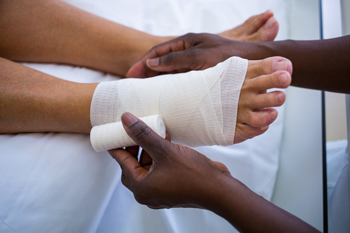 Many diabetic patients are aware of the importance of promptly treating existing foot wounds. There may be serious complications if foot wounds are not treated, which may cause pain and discomfort. Some of the wounds on the feet that can be dangerous to the health of a diabetic patient can include cuts, blisters, or severely dry skin that may result in cracked heels. There are noticeable signs an infection may have developed. These can consist of extreme pain, swelling, and pus may appear surrounding the affected area. Additionally, some patients may experience a high temperature, swollen glands, or a general feeling of being unwell. If you have wounds on your feet, it is strongly advised that you are under the care of a podiatrist who can treat existing wounds.
Many diabetic patients are aware of the importance of promptly treating existing foot wounds. There may be serious complications if foot wounds are not treated, which may cause pain and discomfort. Some of the wounds on the feet that can be dangerous to the health of a diabetic patient can include cuts, blisters, or severely dry skin that may result in cracked heels. There are noticeable signs an infection may have developed. These can consist of extreme pain, swelling, and pus may appear surrounding the affected area. Additionally, some patients may experience a high temperature, swollen glands, or a general feeling of being unwell. If you have wounds on your feet, it is strongly advised that you are under the care of a podiatrist who can treat existing wounds.
Wound care is an important part in dealing with diabetes. If you have diabetes and a foot wound or would like more information about wound care for diabetics, consult with Dr. Dean D. Hinners from Illinois. Our doctor will assess your condition and provide you with quality foot and ankle treatment.
What Is Wound Care?
Wound care is the practice of taking proper care of a wound. This can range from the smallest to the largest of wounds. While everyone can benefit from proper wound care, it is much more important for diabetics. Diabetics often suffer from poor blood circulation which causes wounds to heal much slower than they would in a non-diabetic.
What Is the Importance of Wound Care?
While it may not seem apparent with small ulcers on the foot, for diabetics, any size ulcer can become infected. Diabetics often also suffer from neuropathy, or nerve loss. This means they might not even feel when they have an ulcer on their foot. If the wound becomes severely infected, amputation may be necessary. Therefore, it is of the upmost importance to properly care for any and all foot wounds.
How to Care for Wounds
The best way to care for foot wounds is to prevent them. For diabetics, this means daily inspections of the feet for any signs of abnormalities or ulcers. It is also recommended to see a podiatrist several times a year for a foot inspection. If you do have an ulcer, run the wound under water to clear dirt from the wound; then apply antibiotic ointment to the wound and cover with a bandage. Bandages should be changed daily and keeping pressure off the wound is smart. It is advised to see a podiatrist, who can keep an eye on it.
If you have any questions, please feel free to contact one of our offices located in Metropolis and Eldorado, IL . We offer the newest diagnostic and treatment technologies for all your foot care needs.
Read more about Wound Care
